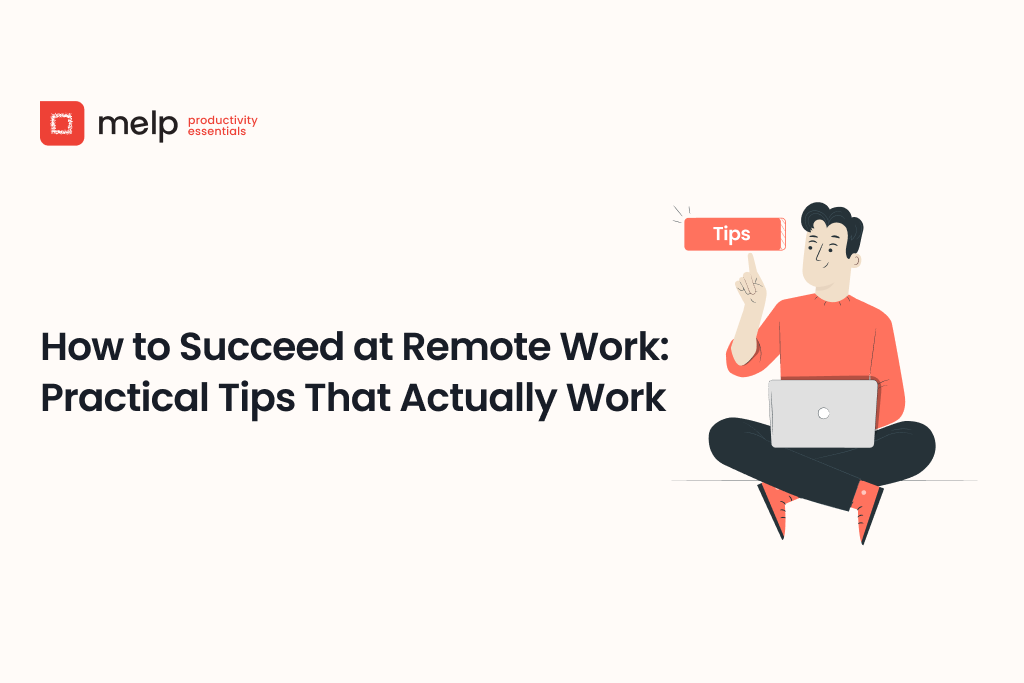
When I first started working from home, I thought it would be easy. I mean, no commute, comfy clothes, and lunch in my kitchen—it sounded perfect. But after a few weeks, I hit a wall. I wasn’t focusing like I used to. I was either working too much or not enough. Over time, though, I figured out some small things that helped me make it work better. Maybe they’ll help you too.
Remote Work Tips: Apply for Success
Create a Workspace That Works for You
In the beginning, I was working from anywhere—the sofa, kitchen table, and sometimes even while standing at the counter. It didn’t feel like work, and I wasn’t really getting anything done. What helped most was setting up a single spot just for work. It didn’t have to be fancy—just a small table with a chair that didn’t hurt my back.

When video meetings became a regular thing, I needed to clean up my background. But honestly, I didn’t always want to tidy the room. That’s when I started using virtual backgrounds. Some platforms like Melp make this easy by letting you choose a clean background, so you look professional even if your space is a bit messy.
Tips:
- Find a quiet corner and stick to it
- Keep your desk simple and distraction-free
- Use a chair that supports you for hours
- Let in some daylight if you can
- Try virtual backgrounds if your space isn’t ideal
Stick to a Daily Routine
One thing I learned quickly: if you don’t create a schedule, the day kind of disappears. I used to roll out of bed and check email, but then I’d forget to eat or take breaks. I felt like I was always working, even when I wasn’t doing much.
So now, I try to start work at the same time each day. I take a lunch break away from my screen, and when I stop for the day, I stop. That routine keeps me feeling more in control.
Tips:
- Start and stop work at regular times
- Take short breaks to stretch or walk
- Step away from the screen during lunch
- Plan out your day in the morning
- Avoid working late unless it’s urgent
Use Tools That Support Smooth Communication
Bad audio or background noise used to ruin my meetings. I didn’t notice it until coworkers kept asking me to repeat myself. So I picked up some better headphones, and that helped. But what made a difference was using software that cuts out background noise.
Some tools, like the Melp team collaboration platform, have built-in noise suppression. That way, barking dogs or traffic outside don’t take over the call. It’s small, but it helps keep the conversation focused.
Tips:
- Use a headset with a good mic
- Mute yourself when you’re not speaking
- Test your camera and sound before joining calls
- Take meetings in the quietest place you can
- Use tools that cancel background noise
Move Throughout the Day
At first, I didn’t realize how little I was moving. I’d sit down after breakfast and not get up until late afternoon. I’d feel stiff and sluggish. That wasn’t working.
Now, I take short breaks every hour. Sometimes I just walk around the room or do a few stretches. Getting my body moving—even a little—makes it easier to stay focused when I sit back down.
Tips:
- Get up once every hour or so
- Walk around during long phone calls
- Stretch your legs, back, and shoulders
- Take a quick walk before or after lunch
- Avoid staying seated for more than two hours at a time
Make Time for Social Interaction
One thing I didn’t expect was how quiet working from home would be. There’s no small talk, no quick chats in the hallway. I started feeling kind of disconnected from everyone.
Now, I try to message a teammate just to say hey, or respond to fun posts in our group chat. Even little things like that help me feel like part of the team again.

Tips:
- Say good morning in your work chat
- Check in with a coworker just to chat
- Join group calls, even if they’re informal
- Respond to non-work topics once in a while
- Don’t isolate—get out and talk to someone if you can
Protect Your Time and Boundaries
One of the hardest parts of working remotely was knowing when to stop. I’d finish dinner, check email one more time, and suddenly I was back in work mode. It wore me out.
Now, I’ve set a cutoff time. After that, no checking Slack, no answering emails. I log off and do something else—even if it’s just sitting quietly. It makes the next day easier.
Tips:
- Set a clear end time for your workday
- Turn off work notifications after hours
- Let coworkers know your availability
- Avoid checking email during off time
- Do something relaxing at the end of your shift
Tips for Working Remotely
Remote work offers flexibility, but to truly thrive, it takes structure and discipline. Whether you’re exploring remote work tips for the first time or searching for ways to stay productive long-term, it’s important to find a routine that suits your lifestyle. These tips for working remotely are designed to help you stay focused, organized, and connected. If you’ve been looking for remote working tips that feel real and actually apply to everyday challenges, this guide is for you.
| Tips | Description |
|---|---|
| Stick to a routine like you would in an office | One of the best remote work tips is to maintain a consistent start and end time to avoid burnout and stay productive. |
| Build a workspace you actually enjoy using | A smart move when learning how to work from home successfully is setting up a clean, dedicated area that feels separate from your personal space. |
| Don’t just work remotely—work mindfully | If you want to know how to remote work well, don’t just log in and grind. Check in with yourself. Are you focused? Distracted? Tired? Adjust as needed. |
| Use tech that simplifies—not complicates—your day | A key part of tips for working remotely is leaning on tools that are easy to use and reduce back-and-forth, like shared task boards or quick voice chats. |
| Set clear goals each morning | To really nail how to successfully work from home, define what a “win” looks like each day. It keeps you aligned even when no one’s watching. |
| Take proper breaks—away from screens | One of the most overlooked tips for remote working is stepping away to refresh. Eat lunch without checking Slack. Breathe. Stretch. Reset. |
| Over-communicate—then communicate more | Wondering how to succeed in a virtual first workplace? Clear, proactive messages matter more than ever. Don’t assume anything. Confirm. |
| Turn off work notifications after hours | A big part of how to succeed as a remote worker is knowing when to stop. Don’t feel guilty about setting boundaries when the workday ends. |
| Schedule face-to-face time virtually | Remote working tips should include connection. Use video chats or casual catch-ups to keep your team bond strong and avoid feeling isolated. |
| Track your progress to stay motivated | Tips for remote workers often ignore momentum. Marking off daily tasks helps you stay accountable and gives a clear sense of achievement. |
Final Word
Remote work isn’t just about working from home. It’s about figuring out how to do your best work in a space that’s also where you live. It takes time, and what works for one person might not work for someone else. But once you get the rhythm right, it can be just as productive—and even more comfortable—than going into an office every day.